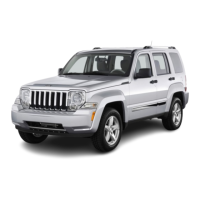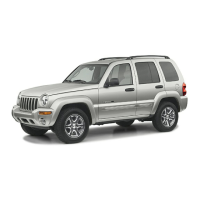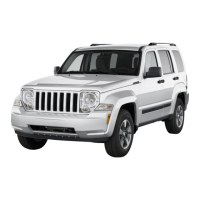Do you have a question about the Jeep Liberty 2008 and is the answer not in the manual?
Utility vehicles have a higher rollover rate due to higher ground clearance and center of gravity.
Guidance on navigating the owner's manual using the table of contents and index.
Manual contains warnings for operating procedures that could result in accident or injury, and cautions for procedures that could damage the vehicle.
Location and importance of the Vehicle Identification Number (VIN).
Details on vehicle keys, ignition removal, reminders, Sentry Key, and key programming.
Explanation of the passive steering wheel lock and how to engage/disengage it.
Monitors doors, liftgate, and ignition for unauthorized entry and operation.
System allowing locking/unlocking doors, liftgate, opening liftgate window, or activating panic alarm remotely.
Operation of manual, power, automatic door locks, child protection locks, and power windows.
Information on seat belts, airbags, and safety restraint systems for all occupants.
Details on manual and automatic dimming rearview mirrors, and outside mirrors.
Information on folding features, power controls, and heating for exterior mirrors.
Voice-activated system for phone calls, including pairing and voice commands.
Details on voice command tree, help command, pairing, dialing, and phonebook management.
Managing incoming calls, making second calls, placing calls on hold, and conference calls.
Manual and power front seat adjustments, head restraints, and heated seats.
Storing and recalling driver seat, mirror, and radio presets.
Procedures for opening and closing the vehicle hood.
Control of exterior and interior lighting, including headlights, parking lights, and fog lights.
Operation of wipers, washers, and mist feature.
Operation of cruise control system for maintaining speed.
Driver aid that senses obstacles behind the vehicle with visible and audible warnings.
HomeLink system for operating garage doors, gates, and security systems.
Location of the power sunroof switch and its operation.
Information on the soft-top, power roof that opens front to rear or rear to front.
Location and operation of the 12-volt power outlet.
115-volt AC outlet for powering small appliances and electronics.
Cargo load floor system, storage bin, and tie-down hooks/loops.
Rear window wiper/washer operation.
Overview of the instrument panel and its components.
Detailed explanation of each indicator light and gauge.
Features and displays of the EVIC system, including status and messages.
Information on radio broadcast signals, AM/FM reception, and electrical disturbance.
Operation of the air conditioning and heating system.
Controls for blower speed, temperature, and air direction.
Automatic climate control system operation and settings.
Steps for starting the vehicle, including adjustments and seat belts.
Precautions for shifting and operating the automatic transmission.
Shifting procedures, recommended shift speeds, and downshifting.
Explains Command-Trac and Selec-Trac II systems, including shift positions.
Guidance for driving on paved roads, considering higher center of gravity.
Advice for driving in snow, mud, sand, and through water.
Procedures for climbing and descending hills, especially steep ones.
How to set and release the parking brake, and warnings for its use.
How ABS aids in maintaining vehicle control under adverse braking conditions.
System enhancing directional control and stability by correcting over/under-steering.
Information on tire markings, treadwear, traction, and temperature grades.
Importance of proper tire inflation, location of placard, and checking procedures.
Warnings about spinning wheels when stuck and potential tire damage.
Benefits of timely tire rotation for wear and performance.
Warnings and information on the TPMS system.
Recommended gasoline octane rating and cautions about fuel additives.
Precautions to prevent carbon monoxide poisoning from exhaust gases.
Location of fuel filler cap and proper filling procedures.
Certification label, GVWR, GAWR, payload, and loading guidelines.
Safety tips and limits for towing trailers, including definitions.
Guidelines for proper break-in of drivetrain components when towing.
Operation of hazard warning flashers for emergency signaling.
Actions to take to reduce potential for engine overheating.
Warnings and instructions for safely jacking the vehicle and changing a tire.
Procedures and warnings for jump-starting a vehicle with booster cables.
Proper towing methods and equipment recommendations.
Illustration and identification of key components in the engine compartment.
Information on the OBD II system and the Malfunction Indicator Light (MIL).
Requirements for passing emissions inspections and OBD II system readiness.
Checking engine oil level, selection, viscosity, and change intervals.
Symptoms of a plugged fuel filter and need for service.
Requirements for catalytic converter operation and potential damage prevention.
Warnings and procedures related to the cooling system, including fan and pressure cap.
When and how to check power steering fluid level.
Periodic inspection of brake system components and suggested service intervals.
Checking brake fluid level, especially when warning light is on.
Fluid level check and fluid/filter change intervals.
Fluid level check, lubricant selection, and fluid change frequency.
Fluid level check, lubricant selection, and fluid change frequency.
Fluid level check, adding fluid, lubricant selection, and change frequency.
Causes of corrosion and recommendations for preventing it.
Recommended procedures for washing the vehicle's exterior.
Cleaning interior trim, vinyl upholstery, and leather upholstery.
Location and description of fuses in the TIPM.
Procedures for replacing various interior and exterior light bulbs.
Scheduled maintenance for emission control system for proper functioning.
General maintenance schedule including oil changes, tire rotation, and filter replacements.
Table detailing maintenance items and their required intervals by miles, kilometers, or months.
Tips for preparing for service appointments and making requests.
Contact information for customer assistance centers and dealerships.
Procedures for reporting safety defects to NHTSA and the manufacturer.
Explanation of tire grading categories: Treadwear, Traction, and Temperature.
Utility vehicles have a higher rollover rate due to higher ground clearance and center of gravity.
Guidance on navigating the owner's manual using the table of contents and index.
Manual contains warnings for operating procedures that could result in accident or injury, and cautions for procedures that could damage the vehicle.
Location and importance of the Vehicle Identification Number (VIN).
Details on vehicle keys, ignition removal, reminders, Sentry Key, and key programming.
Explanation of the passive steering wheel lock and how to engage/disengage it.
Monitors doors, liftgate, and ignition for unauthorized entry and operation.
System allowing locking/unlocking doors, liftgate, opening liftgate window, or activating panic alarm remotely.
Operation of manual, power, automatic door locks, child protection locks, and power windows.
Information on seat belts, airbags, and safety restraint systems for all occupants.
Details on manual and automatic dimming rearview mirrors, and outside mirrors.
Information on folding features, power controls, and heating for exterior mirrors.
Voice-activated system for phone calls, including pairing and voice commands.
Details on voice command tree, help command, pairing, dialing, and phonebook management.
Managing incoming calls, making second calls, placing calls on hold, and conference calls.
Manual and power front seat adjustments, head restraints, and heated seats.
Storing and recalling driver seat, mirror, and radio presets.
Procedures for opening and closing the vehicle hood.
Control of exterior and interior lighting, including headlights, parking lights, and fog lights.
Operation of wipers, washers, and mist feature.
Operation of cruise control system for maintaining speed.
Driver aid that senses obstacles behind the vehicle with visible and audible warnings.
HomeLink system for operating garage doors, gates, and security systems.
Location of the power sunroof switch and its operation.
Information on the soft-top, power roof that opens front to rear or rear to front.
Location and operation of the 12-volt power outlet.
115-volt AC outlet for powering small appliances and electronics.
Cargo load floor system, storage bin, and tie-down hooks/loops.
Rear window wiper/washer operation.
Overview of the instrument panel and its components.
Detailed explanation of each indicator light and gauge.
Features and displays of the EVIC system, including status and messages.
Information on radio broadcast signals, AM/FM reception, and electrical disturbance.
Operation of the air conditioning and heating system.
Controls for blower speed, temperature, and air direction.
Automatic climate control system operation and settings.
Steps for starting the vehicle, including adjustments and seat belts.
Precautions for shifting and operating the automatic transmission.
Shifting procedures, recommended shift speeds, and downshifting.
Explains Command-Trac and Selec-Trac II systems, including shift positions.
Guidance for driving on paved roads, considering higher center of gravity.
Advice for driving in snow, mud, sand, and through water.
Procedures for climbing and descending hills, especially steep ones.
How to set and release the parking brake, and warnings for its use.
How ABS aids in maintaining vehicle control under adverse braking conditions.
System enhancing directional control and stability by correcting over/under-steering.
Information on tire markings, treadwear, traction, and temperature grades.
Importance of proper tire inflation, location of placard, and checking procedures.
Warnings about spinning wheels when stuck and potential tire damage.
Benefits of timely tire rotation for wear and performance.
Warnings and information on the TPMS system.
Recommended gasoline octane rating and cautions about fuel additives.
Precautions to prevent carbon monoxide poisoning from exhaust gases.
Location of fuel filler cap and proper filling procedures.
Certification label, GVWR, GAWR, payload, and loading guidelines.
Safety tips and limits for towing trailers, including definitions.
Guidelines for proper break-in of drivetrain components when towing.
Operation of hazard warning flashers for emergency signaling.
Actions to take to reduce potential for engine overheating.
Warnings and instructions for safely jacking the vehicle and changing a tire.
Procedures and warnings for jump-starting a vehicle with booster cables.
Proper towing methods and equipment recommendations.
Illustration and identification of key components in the engine compartment.
Information on the OBD II system and the Malfunction Indicator Light (MIL).
Requirements for passing emissions inspections and OBD II system readiness.
Checking engine oil level, selection, viscosity, and change intervals.
Symptoms of a plugged fuel filter and need for service.
Requirements for catalytic converter operation and potential damage prevention.
Warnings and procedures related to the cooling system, including fan and pressure cap.
When and how to check power steering fluid level.
Periodic inspection of brake system components and suggested service intervals.
Checking brake fluid level, especially when warning light is on.
Fluid level check and fluid/filter change intervals.
Fluid level check, lubricant selection, and fluid change frequency.
Fluid level check, lubricant selection, and fluid change frequency.
Fluid level check, adding fluid, lubricant selection, and change frequency.
Causes of corrosion and recommendations for preventing it.
Recommended procedures for washing the vehicle's exterior.
Cleaning interior trim, vinyl upholstery, and leather upholstery.
Location and description of fuses in the TIPM.
Procedures for replacing various interior and exterior light bulbs.
Scheduled maintenance for emission control system for proper functioning.
General maintenance schedule including oil changes, tire rotation, and filter replacements.
Table detailing maintenance items and their required intervals by miles, kilometers, or months.
Tips for preparing for service appointments and making requests.
Contact information for customer assistance centers and dealerships.
Procedures for reporting safety defects to NHTSA and the manufacturer.
Explanation of tire grading categories: Treadwear, Traction, and Temperature.
| Brand | Jeep |
|---|---|
| Model | Liberty 2008 |
| Category | Automobile |
| Language | English |











